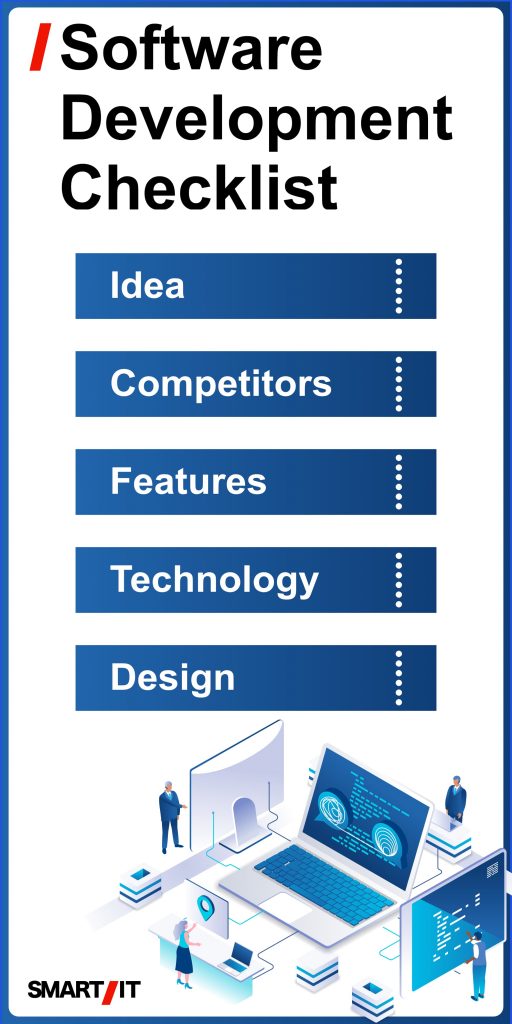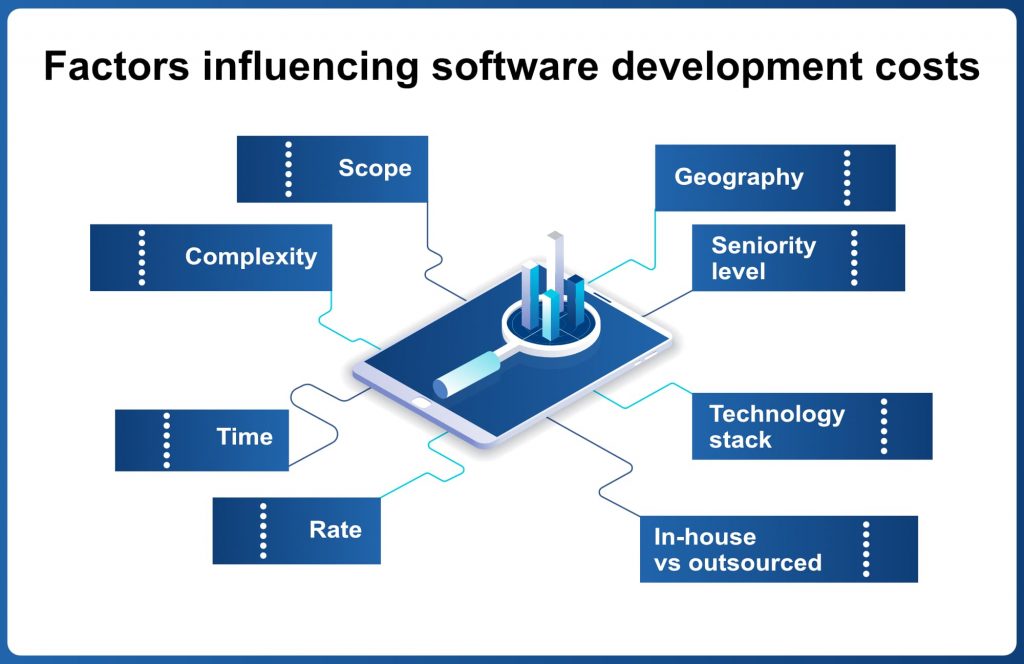Ever wonder how much it costs to make new software? Most companies will think twice before splashing out on software engineering teams, provided they have them in the first place. And this happens with due reason.
The cost of software development can vary drastically, depending on very trivial, but nonetheless important factors. Depending on the type of business you are running, an online or offline one, and the size of your company, local startup or global enterprise – the decision to develop software can be very straightforward or very difficult indeed.
Luckily, we have these factors covered here. Dive into custom software development pricing with our latest breakdown of all things software engineering and IT.
Average software development costs
When you start a digital project, you or your stakeholders will most likely want to hear a ball-park figure of the cost of software development. Be safe to assume that time equals money. As a result, your software development costs will likely be calculated by the hour.
What is more, depending on how fast you need to receive deliverables or reach a set milestone, you will decide on how many professionals will be involved.
There will also be things you will have to keep in mind regardless of how fleshed out your idea is. One such thing is where your software will be available. In other words, what platform users will be able to access it.
Below is a visual representation of how many hours would be required for software solutions built for different platforms. The average software development rate in this case is $50 per hour—less than what an average US developer makes per hour, but more than the smallest rate in Asia.
| Solution | Platform | Time (hrs) | Cost ($) |
|---|---|---|---|
| Vehicle insurance app | Web | 15,360 | 768,000 |
| iOS | 1,960 | 98,000 | |
| Android | 1,980 | 98,000 | |
| Banking ERP software | Desktop | 2,400 | 120,000 |
| Web | 5,760 | 288,000 | |
| Healthcare CRM solution | Desktop | 2,510 | 125,000 |
| Web | 5,760 | 288,000 | |
| E-commerce platform | Web | 1,600 | 80,000 |
| Blockchain wallet | Web | 1,440 | 72,000 |
| iOS | 1,500 | 75,000 | |
| Android | 1,530 | 76,500 |
You can also estimate the weekly cost of development based on the number of people you hire by using this simple formula:
Cost per week = Hourly rate x Hrs per week x No. of Developers
The formula works for both in-house hires and the cost of software outsourcing to third party developers. But more on that after the checklist.
Software development checklist
To get the best cost estimate, provide as many details as possible to whomever is doing software development for you. Assuming you are requesting a quote from a third-party developer—this is the checklist for you.

Use it as a reference to build a project description or as a starting point for the software you want developed.
- Idea — What is your elevator pitch for your software product or service? Use the 5W1H method to get your idea across to your software development partner in broad strokes.
- Competitors — Naming a few potential or actual competitors is a great way to highlight the milestones that need to be accomplished for your software to stand a chance against existing market players.
- Features — What are the must-have features? This is also known as the functional specification. It tells developers what your software must do and how it should behave.
- Technology — What programming languages, frameworks and APIs do you need to use? If you have a full tech spec (technical specification) or know the technology stack you want to use—share this with your software development partner. Their job will be that much easier as they can match a candidate’s skill set with specific requirements.
- Design — What look and feel are you going for with your application or software program? A few basic wireframes or even references can really help your software partner push the envelope in terms of the user interface and overall product design. Every little bit helps.
Remember, you do not have to have your idea down on paper one hundred percent. You are most likely to make changes and adjustments as you go anyway. However, if you do not come from a technical background and require help with building an MVP to justify launching your product to market, your software services provider will be able to help.
Factors influencing software development costs
The costs of software engineering and the factors that affect them are plentiful. And while we have done our best to account for the most crucial ones, there will always be more.

If you have not given thought to these points, they can be a worthwhile time investment. Not only will they help optimize project expenses, but will also fine-tune your efforts in searching for a viable partner.
Scope
Even though the project scope statement can be defined once costs are accounted for, it is still crucial to define project boundaries and responsibilities. This can be anything as simple as listing the deliverables or going into detail on budgeting, roles, and goals.
Once you have a rough idea of where the project begins and where it ends, change management during software development becomes easier. And changes there will be. No scope is ever truly set in stone. By taking the time to outline project scope you save yourself the headache of juggling too many balls in the future.
Complexity
Complexity simply speaks to how difficult it will be to get your software off the ground. This often hinges on how many system components will have to be involved and how they will interact with one another.
In very simple terms, the more databases, APIs and core system components have to interoperate, the more complex will be the development. In other words, it will require more time and resources to get to the required outcome.
Time
Set a deadline. We all know that software development and maintenance is an ongoing process. But by not setting a tentative finish line or putting your project on a schedule could cost a penny or two.
Do not worry about splitting work into time slots or plotting out every single task to be done on a timeline. You can shoulder that burden and take care of the project management plan at later stages. The takeaways is this—have an idea of when you want the software delivered.
Rate
It should not come as a surprise that software developers make five to six-figure sums annually in the US. This makes software development costs a delicate subject for most employers.
What if we told you that for the same hourly rate as in the US, you could have 3 no less experienced software engineers crunching code on your project? Depending on the geography of your provider, your software outsourcing costs could be in the $25-$50 per hour mark.
And if you still have any doubts as to the skills of outsourced developers, check this index of how different countries fare in the mathematics, sciences and reading departments.
TL;DR Eastern Europe confidently populates the list.
Geography
As trivial as it may sound, the hourly costs of software engineering differ from country to country. Despite software development being an international trade, wages are still often defined based on what part of the world the developers are in.
Intersecting with the previous point on rates and software development costing, Asia and Eastern Europe often lead the development hub charts as being some of the most budget friendly locations.
Seniority level
By now you have probably heard that software developers can be divided into three seniority levels—Junior, Middle and Senior. Each title normally corresponds to the number of years the engineer has spent working with a certain technology stack or project.
- Junior (0-1 yr)
- Middle (1-3+ yrs)
- Senior (>5 yrs)
The higher this level, the bigger the rate for such a developer. However, these levels can differ based on the developers’ tech stack of choice.
Technology stack
The tech stack refers to the set of programming languages, frameworks, databases, APIs and other tools that software engineers are versed in.
The broader the tech stack is required for a project, the higher the rate for a single developer will be.
It is likely safe to assume that a developer fluent in one technology stack, can quickly upgrade their skills in a different one. The more years of experience they have overall, the quicker that upgrade will be.
In-house vs outsourced
Last but not least, software outsourcing costs are definitely cheaper than hiring in-house. Building a dedicated development center can help cut costs both in the short and the long term.
The difference between hiring locally and contracting a third-party provider is that with the former there are overhead costs. Such costs relate to work benefits, taxes, and workplace amenities.
With the latter, the software provider handles these costs and provides the same service your in-house team would offer, but at a much more affordable rate.
Software development pricing models
When it comes to software development pricing models T&M and Fixed cost will be the most frequent ones you will meet. Below is a summary of the two and who they will benefit.
Time and material
The T&M pricing model is the sum of hours spent working (Time) per software developer (Material). You will find the formula above handy to calculate weekly and monthly costs based on the number of engineers you hire or source from a provider.
This pricing model is best for companies without a fixed budget, who plan to engage in long-term software development.
Fixed cost
The Fixed Cost pricing model means you get what you pay for. No more, no less—exceptions can come under contract clauses.
Use this model if you are operating on a tight budget and have a short-term project with clear deliverables. Post-delivery support and maintenance will most likely come at an additional cost, unless stipulated in advance.
If you want to learn more about staffing and pricing, we speak at length about them in our software development engagement models guide.
You make the call
Accounting for everything when it comes to the costs to make a new software can seem like an insurmountable task. Truth is, more people are building custom software than you think.
Hopefully, the factors listed here and the checklist will help you make quick work of making your software product or service a reality. In the very least we hope it steers you closer towards a viable partnership with a third party developer.
Whatever project you are nursing and whatever your constraints are we hope this guide serves as your map for software development costs. And that it makes your call that much easier to make.
14 September 2020

 Pavel Kaplunou
,
Pavel Kaplunou
, 



